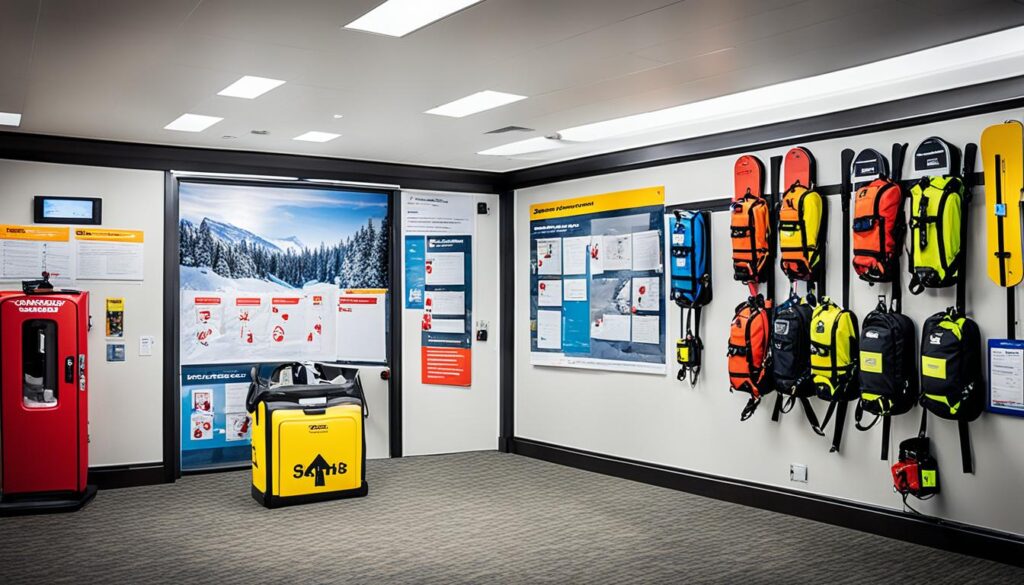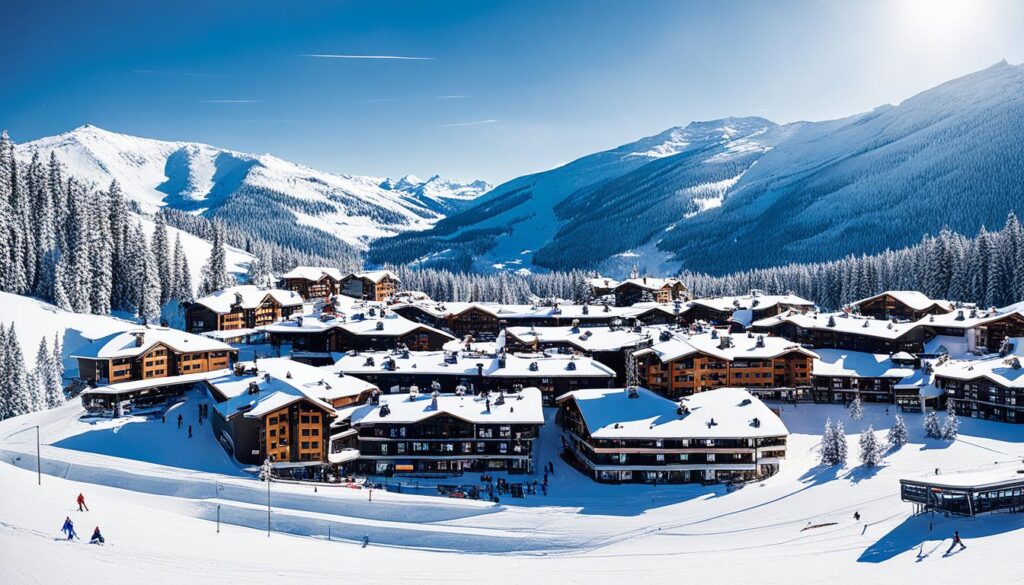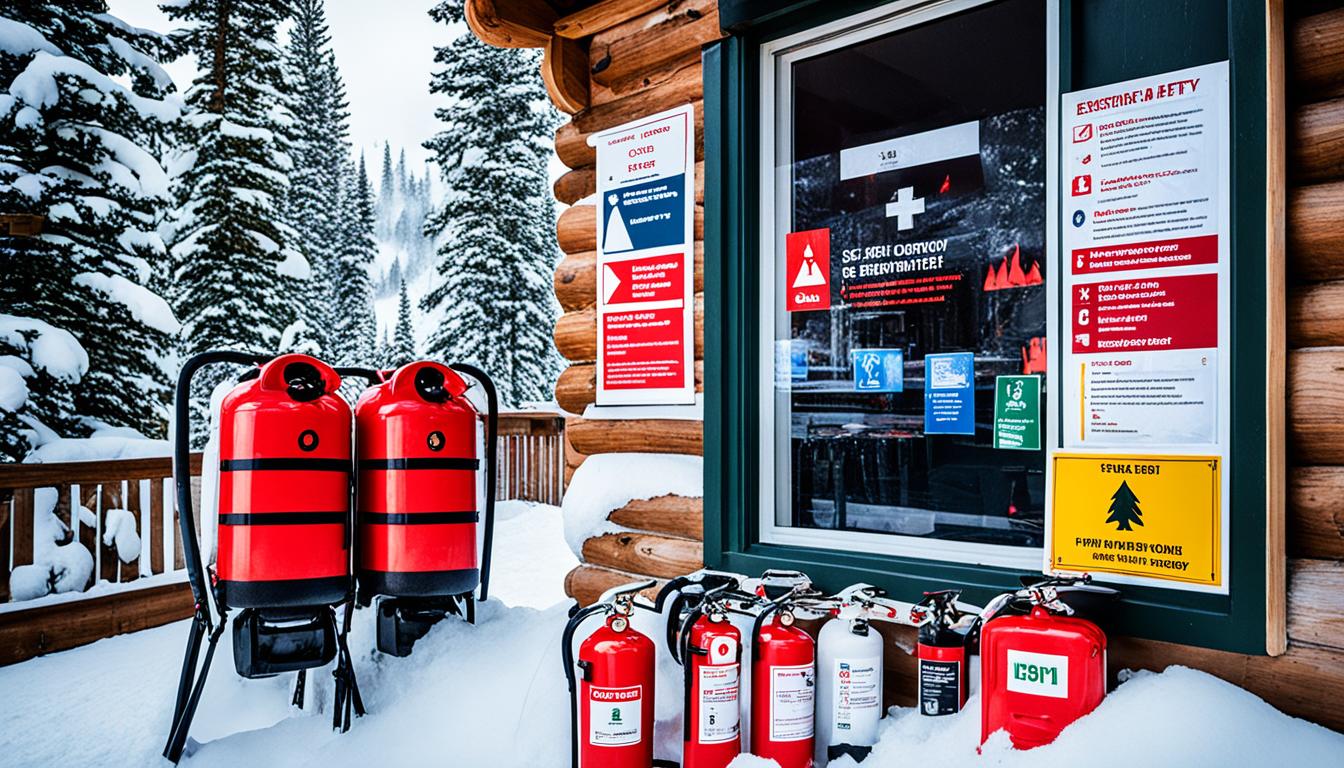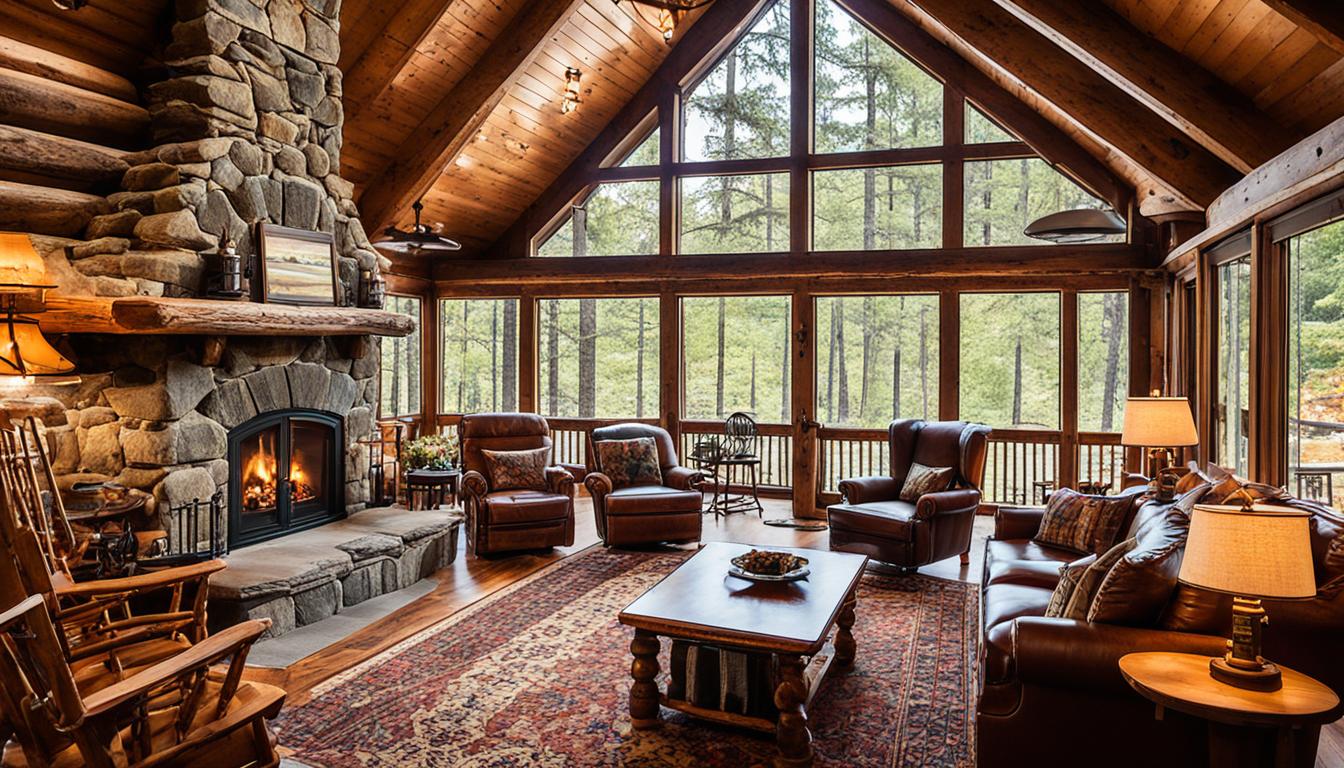Welcome to our article on ski lodge safety features. Safety is crucial when enjoying winter sports like skiing. Ski lodges work hard to create a safe space for guests. They use different methods to ensure everyone’s wellbeing. In this article, we’ll explore the safety and security features you’ll find at ski lodges and resorts. We’ll also share some important tips for staying safe while skiing.
Key Takeaways:
- Surveillance systems, emergency protocols, and access control are some of the safety features implemented at ski lodges.
- Using the buddy system, wearing protective gear, and following resort guidelines are essential for safe skiing.
- Ski resorts have designated slow zones, marked boundaries, and terrain safety guidelines to maintain security and prevent accidents.
- Proper conditioning and equipment, as well as staying within resort boundaries, are important for a safe skiing experience.
- By practicing these safety measures, you can enjoy a winter vacation with peace of mind.
Tips for Safe Skiing on the Slopes
Skiing is a thrilling sport, but it’s important to stay safe. No matter your skill level, a few tips can make your ski trip both safe and fun.
Use the buddy system: Always ski with a friend, especially in tricky areas. Having someone with you not only is enjoyable but also makes things safer during accidents.
Carry a cell phone: Ensure your phone is with you. It’s crucial for calling help if needed, improving your safety.
Wear protective gear: Gear like helmets, elbow, and knee pads are a must. They lower the risk of severe injuries, making your skiing safer.
Use well-maintained equipment: Check your gear before skiing. Make sure your skis, boots, and bindings are in top shape to avoid accidents.
Dress for the weather: How you dress matters for safe skiing. Layer up for warmth, and always wear sunscreen to shield from sunburn.
Learn proper skiing techniques: Lessons from experts can make your skiing safer. Knowing how to stop and turn reduces accident risks.
Follow resort etiquette: Ski resorts have rules for safety. Always respect and follow these, like staying in marked areas and yielding when needed.
By applying these seven safety tips, your skiing experience can be great. Plus, you’ll lower the chances of getting hurt on the snow.
Safety Checklist for Safe Skiing
| Checklist | Items |
|---|---|
| 1. | Helmet |
| 2. | Elbow pads |
| 3. | Knee pads |
| 4. | Cell phone |
| 5. | Well-maintained ski equipment |
| 6. | Appropriate attire |
| 7. | Skiing lessons |
| 8. | Resort guidelines |
Safety Measures at Ski Resorts
Ski resorts are very focused on keeping their guests safe. They have many rules and methods to do this. Let’s look at some of the important measures they take.
- They have areas on the slopes where skiers of different levels must go slow. This keeps everyone safe from accidents.
- Ski resorts also mark the edges of their ski areas very clearly. It’s important for guests to not go past these boundaries. This is for their own safety.
- There are different guidelines for safety on various terrains. This includes information on how to ski safely in freestyle terrain or in the backcountry. These rules help lower the chance of accidents.
- Another important safety measure is the resort’s codes of conduct. These rules are there to make sure everyone skis responsibly. Following these rules makes the skiing experience better for all.
These safety steps are all in place to make sure guests have a great time. People can enjoy skiing knowing the resort has their safety as a top concern.
Ski Resort Safety Measures
| Safety Measure | Description |
|---|---|
| Designated Slow Zones and Family Zones | Specific areas on the slopes where skiers of different abilities are expected to travel at appropriate speeds and provide adequate space for others. |
| Marked Resort Boundaries | Clear demarcation of ski area boundaries to ensure guests stay within safe areas and avoid potential hazards. |
| Terrain Safety Guidelines | Specific guidelines for navigating freestyle terrain and backcountry skiing safely. |
| Codes of Conduct | Sets of rules and etiquette that promote responsible skiing and educate guests about safety. |
Preparing for Skiing: Conditioning and Equipment
To get ready for skiing, you need to be in good shape to avoid getting hurt. Physical therapists say it’s smart to do warm-up exercises. These focus on the muscles you use in skiing. This helps your body get ready for the hard work and lowers the chance of getting hurt.
Keeping up with your stamina and lessening muscle tiredness is key. Doing things like running or cycling can boost your energy and fitness. It’s also good to do strength exercises for your legs, core, and upper body. This gives you the strength and balance you need for skiing.
Having the right gear is also crucial for staying safe. For backcountry skiing, it’s a must to have safety equipment like avalanche beacons, shovels, and probes. These tools can save your life if an avalanche happens. Plus, taking courses on avalanche safety can teach you how to ski in wild areas safely.
At ski lodges or resorts, following the safety rules is a big deal. These rules help keep all guests safe. Learn about the lodge’s emergency plans. Also, always obey what the staff tells you to have a fun and safe time skiing.
Dressing for Safety and Comfort
Wearing the right clothes is essential for staying safe while skiing. Layering your clothes lets you adjust to the weather. Pick base layers that draw moisture away. Wear jackets and pants that keep you warm. And remember your gloves, goggles, and helmet. They protect you and lower the risk of getting hurt.
Image: Ski Lodge Emergency Protocols

Skiing Within Resort Boundaries
When you ski in resort areas, keep safe by following their rules. This makes sure your skiing is fun and safe.
-
Obey posted signs: Be alert for signs inside the resort. They tell you about the snow, dangers, and rules. Following these signs keeps you and other skiers safe.
-
Stay in skiing zones: Resorts mark safe areas for skiing. Go only where it’s allowed to avoid accidents. Stay away from off-limits areas and ski safely away from trees to prevent harm.
-
Control your speed: Ski carefully at the right speed. Don’t go too fast for your skills or the conditions. This lowers the risk of crashes and makes things safer for all.
-
Yield to those downhill: Give way to skiers below you. This prevents accidents and keeps everyone safe on the mountain.
-
Watch out around you: Keep an eye out while skiing. Watch for hidden dangers like rocks or trees. Being alert helps you avoid problems and stay safe.
Your safety matters most when skiing in resorts. By obeying the resort’s rules and guidelines, your skiing trip will be full of joy with less worry about getting hurt.

Conclusion
Ski lodges and resorts make sure guests stay safe. They use cameras, plans for emergencies, and check who goes in. This helps make the area safe for everyone.
For a great vacation, skiers must be safe too. They should wear protective gear like helmets. Also, it’s important to only use the right skiing equipment and stay where it’s safe.
With these steps, skiers can have fun with less worry. Ski areas work hard to keep vacations safe and fun. They want every guest to have a great time, knowing they are protected.
FAQ
What safety measures are in place at ski lodges?
Ski lodges put safety first. They use cameras, have plans for emergencies, and check who comes in. This keeps everyone safe.
How can I stay safe while skiing?
To have a safe ski day, bring a buddy. Always have a phone with you. Wear the right gear and know the rules.
What safety measures do ski resorts have in place?
Ski resorts mark where you should go slow and where families are welcome. They set rules for being safe in different areas and teach how to ski safely.
How can I prepare physically for skiing?
To get ready for skiing, warm up your muscles. This makes you less tired and able to ski longer. Fitness is key.
What equipment should I use when skiing?
For off-trail skiing, have gear for avalanches. This means a beacon, a shovel, and a probe. Know how to be safe in the snow.
What should I keep in mind when skiing within resort boundaries?
Inside the resort, follow all signs and rules. Stay where you’re supposed to ski. Keep control, look around, and avoid hidden dangers.




